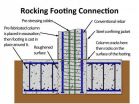(Press-News.org) Research to curb global warming caused by rising levels of atmospheric greenhouse gases, such as carbon dioxide, usually involves three areas: Developing alternative energy sources, capturing and storing greenhouse gases, and repurposing excess greenhouse gases. Drawing on two of these approaches, researchers in the laboratory of Andrew Bocarsly, a Princeton professor of chemistry, collaborated with start-up company Liquid Light Inc. of Monmouth Junction, N.J. to devise an efficient method for harnessing sunlight to convert carbon dioxide into a potential alternative fuel known as formic acid. The study was published June 13 in the Journal of CO2 Utilization.
The transformation from carbon dioxide and water to formic acid was powered by a commercial solar panel generously provided by the energy company PSE&G that can be found atop electric poles across the state. The process takes place inside an electrochemical cell, which consists of metal plates the size of rectangular lunch-boxes that enclose liquid-carrying channels.
To maximize the efficiency of the system, the amount of power produced by the solar panel must match the amount of power the electrochemical cell can handle, said Bocarsly. This optimization process is called impedance matching. By stacking three electrochemical cells together, the research team was able to reach almost 2 percent energy efficiency, which is twice the efficiency of natural photosynthesis. It is also the best energy efficiency reported to date using a man-made device.
A number of energy companies are interested in storing solar energy as formic acid in fuel cells. Additionally, formate salt—readily made from formic acid—is the preferred de-icing agent on airplane runways because it is less corrosive to planes and safer for the environment than chloride salts. With increased availability, formate salts could supplant more harmful salts in widespread use.
Using waste carbon dioxide and easily obtained machined parts, this approach offers a promising route to a renewable fuel, Bocarsly said.
INFORMATION:
Read the full article here:
White, J. L.; Herb, J. T.; Kaczur, J. J.; Majsztrik, P. W.; Bocarsly, A. B. "Photons to formate: Efficient electrochemical solar energy conversion via reduction of carbon dioxide." Journal of CO2 Utilization. Available online June 13, 2014.
Solar panels light the way from carbon dioxide to fuel
2014-07-01
ELSE PRESS RELEASES FROM THIS DATE:
Poor physical, financial health driven by same factors
2014-07-01
Poor physical health and financial health are driven by the same underlying psychological factors, finds a new study out of the Olin Business School at Washington University in St. Louis.
Researchers Lamar Pierce, PhD, associate professor of strategy at Olin and PhD-candidate Timothy Gubler found that the decision to contribute to a 401(k) retirement plan predicted whether or not an individual will act to correct poor physical health indicators revealed during an employer-sponsored health examination.
"We find that existing retirement contribution patterns and future ...
Blind lead the way in brave new world of tactile technology
2014-07-01
Imagine feeling a slimy jellyfish, a prickly cactus or map directions on your iPad mini Retina display, because that's where tactile technology is headed. But you'll need more than just an index finger to feel your way around.
New research at UC Berkeley has found that people are better and faster at navigating tactile technology when using both hands and several fingers. Moreover, blind people in the study outmaneuvered their sighted counterparts – especially when using both hands and several fingers – possibly because they've developed superior cognitive strategies ...
Engaging parents, community to map student success in South King County
2014-07-01
If we had a road map to what parental involvement in schools should be, what would it look like? Would it be a straight line, or a complicated maze of cross streets going in every direction?
University of Washington researchers studied The Road Map Project, a collaborative effort to dramatically improve student achievement in seven school districts in South Seattle and South King County. In their report after a yearlong study of the initiative, they found that students were most successful when schools and communities found creative and culturally responsive ways of engaging ...
For cancer patients, sugar-coated cells are deadly
2014-07-01
ITHACA, N.Y. – Every living cell's surface has a protein-embedded membrane that's covered in polysaccharide chains – a literal sugar coating. A new study by a Cornell University researcher found this coating is especially thick and pronounced on cancer cells and is a crucial determinant of the cell's survival.
Consisting of long, sugar-decorated molecules called glycoproteins, the coating causes physical changes in the cell membrane that make the cell better able to thrive – leading to a more lethal cancer.
Matthew Paszek, assistant professor of chemical and biomolecular ...
Clemson scientists: Kudzu can release soil carbon, accelerate global warming
2014-07-01
CLEMSON, S.C. — Clemson University scientists are shedding new light on how invasion by exotic plant species affects the ability of soil to store greenhouse gases. The research could have far-reaching implications for how we manage agricultural land and native ecosystems.
In a paper published in the scientific journal New Phytologist, plant ecologist Nishanth Tharayil and graduate student Mioko Tamura show that invasive plants can accelerate the greenhouse effect by releasing carbon stored in soil into the atmosphere.
Since soil stores more carbon than both the atmosphere ...
Cellular gates for sodium and calcium controlled by common element of ancient origin
2014-07-01
Researchers at Johns Hopkins have spotted a strong family trait in two distant relatives: The channels that permit entry of sodium and calcium ions into cells turn out to share similar means for regulating ion intake, they say. Both types of channels are critical to life. Having the right concentrations of sodium and calcium ions in cells enables healthy brain communication, heart contraction and many other processes. The new evidence is likely to aid development of drugs for channel-linked diseases ranging from epilepsy to heart ailments to muscle weakness.
"This discovery ...
Mayo Clinic: Proton therapy has advantages over IMRT for advanced head and neck cancers
2014-07-01
Rochester, Minn. -- A new study by radiation oncologists at Mayo Clinic comparing the world's literature on outcomes of proton beam therapy in the treatment of a variety of advanced head and neck cancers of the skull base compared to intensity modulated radiation therapy (IMRT) has found that proton beam therapy significantly improved disease free survival and tumor control when compared to IMRT. The results appear in the journal Lancet Oncology.
"We undertook a systematic review and meta-analysis to compare the clinical outcomes of patients treated with proton therapy ...
Video games could provide venue for exploring sustainability concepts
2014-07-01
CORVALLIS, Ore. – Could playing video games help people understand and address global sustainability issues such as pollution, drought or climate change? At least two researchers believe so, outlining their argument in a concept paper published in the journal First Monday.
Video games have the potential to educate the public and encourage development of creative solutions to social, economic and environmental problems, said Oregon State University's Shawna Kelly, one of the two authors of the article.
"Video games encourage creative and strategic thinking, which could ...
Studies: Addiction starts with an overcorrection in the brain
2014-07-01
The National Institutes of Health has turned to neuroscientists at the nation's most "Stone Cold Sober" university for help finding ways to treat drug and alcohol addiction.
Brigham Young University professor Scott Steffensen and his collaborators have published three new scientific papers that detail the brain mechanisms involved with addictive substances. And the NIH thinks Steffensen's on the right track, as evidenced by a $2-million grant that will help fund projects in his BYU lab for the next five years.
"Addiction is a brain disease that could be treated like ...
New bridge design improves earthquake resistance, reduces damage and speeds construction
2014-07-01
SEATTLE, Wash. - Researchers have developed a new design for the framework of columns and beams that support bridges, called "bents," to improve performance for better resistance to earthquakes, less damage and faster on-site construction.
The faster construction is achieved by pre-fabricating the columns and beams off-site and shipping them to the site, where they are erected and connected quickly.
"The design of reinforced concrete bridges in seismic regions has changed little since the mid-1970s," said John Stanton, a professor in the Department of Civil and Environmental ...


